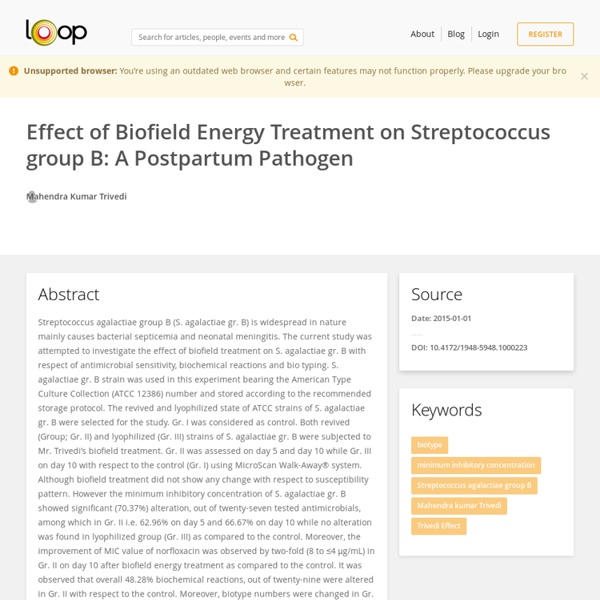



Alteration of Gr.II Streptococcus Agalactiae Biotype Number Abstract Streptococcus agalactiae group B (S. agalactiae gr. B) is widespread in nature mainly causes bacterial septicemia and neonatal meningitis. The current study was attempted to investigate the effect of biofield treatment on S. agalactiae gr. B with respect of antimicrobial sensitivity, biochemical reactions and bio typing. Citation Information Mahendra Kumar Trivedi.
Study of Streptococcus Agalactiae Characteristics Alterations Citation: Trivedi MK, Branton A, Trivedi D, Nayak G, Shettigar H, et al. (2015) Effect of Bioeld Energy Treatment on Streptococcus group B: A Postpartum Pathogen. J Microb Biochem Technol 7: 269-273. doi:10.4172/1948-5948.1000223 Volume 7(5): 269-273 (2015) - 270 J Microb Biochem Technol ISSN: 1948-5948 JMBT, an open access journal bioeld treatment that is also called as Trivedi eect®. unique bioeld treatment has been known to transform the structural, physical, and thermal properties of several metals in material science [12-14], improved the overall productivity of crops [15,16], altered characteristics features of microbes [17-19] and improved growth and anatomical characteristics of various medicinal plants [20,21]. Due to the clinical signicance of this organism and literature reports on bioeld treatment, the present work was undertaken to evaluate the impact of bioeld treatment on S. agalactiae group B in relation to antimicrobials susceptibility and bio typing based on (Gr.). e Gr.
Biofield Treatment on Streptococcus group B – Read more Citation: Trivedi MK, Branton A, Trivedi D, Nayak G, Shettigar H, et al. (2015) Effect of Bioeld Energy Treatment on Streptococcus group B: A Postpartum Pathogen. J Microb Biochem Technol 7: 269-273. doi:10.4172/1948-5948.1000223 Volume 7(5): 269-273 (2015) - 270 J Microb Biochem Technol ISSN: 1948-5948 JMBT, an open access journal bioeld treatment that is also called as Trivedi eect . unique bioeld treatment has been known to transform the structural, physical, and thermal properties of several metals in material science [12-14], improved the overall productivity of crops [15,16], altered characteristics features of microbes [17-19] and improved growth and anatomical characteristics of various medicinal plants [20,21]. Due to the clinical signicance of this organism and literature reports on bioeld treatment, the present work was undertaken to evaluate the impact of bioeld treatment on S. agalactiae group B in relation to antimicrobials susceptibility and bio typing based on (Dade Behring
Study of 16s rDNA Sequencing of Nocardia Otitidis Title: Evaluation of Antibiogram, Genotype and Phylogenetic Analysis of Biofield Treated Nocardia otitidis Publication: Biological Systems: Open Access Select license: Creative Commons Attributions-NonCommercial-ShareAlike Updated: November 21st, 2016 Abstract: Nocardiosis is a soil-borne aerobic infection caused by Nocardia species commonly affects the respiratory tract.
DNA Polymorphism of Nocardia otitidis & Biofield Treatment Citation: Trivedi MK, Branton A, Trivedi D, Nayak G, Mondal SC, et al. (2015) Evaluation of Antibiogram, Genotype and Phylogenetic Analysis of Bioeld Treated Nocardia otitidis. Biol Syst Open Access 4: 143. doi:10.4172/2329-6577.1000143 Page 2 of 6 Volume 4 • Issue 2 • 1000143 Biol Syst Open Access ISSN: 2329-6577 BSO, an open access journal Ampere’s law, which states that the moving charge produces magnetic elds in the surrounding space [15,16]. electromagnetic waves in the form of bio-photons that is also known as ultra-weak photon emissions (UPE). is commonly known as bioeld. electromagnetic eld, being generated by moving electrically charged particles (ions, cell, molecule, etc.) inside the human body [17]. transfer of information from cell to cell or DNA or storage by biophotons has been demonstrated in plants, bacteria, animal neutriophil granulocytes and kidney cells [18]. various scientic instruments such as Kirlian photography, polycontrast the Globe. bioeld energy treatment. kit.
Mahendra Kumar Trivedi | Journal of Microbial & Biochemical Technology Abstract Streptococcus agalactiae group B (S. agalactiae gr. B) is widespread in nature mainly causes bacterial septicemia and neonatal meningitis. The current study was attempted to investigate the effect of biofield treatment on S. agalactiae gr. B with respect of antimicrobial sensitivity, biochemical reactions and bio typing. S. agalactiae gr.
Antimicrobial Susceptibility Testing of Burkholderia Cepacia Abstract Burkholderia cepacia (B. cepacia) is an opportunistic, Gram negative pathogen which causes infection mainly in immunocompromised population and associated with high rate of morbidity and mortality in cystic fibrosis patients. Aim of the present study was to analyze the impact of biofield treatment on multidrug resistant B. cepacia. Clinical sample of B. cepacia was divided into two groups i.e. control and biofield treated. Citation Information Mahendra Kumar Trivedi. Burkholderia Cepacia Antimicrobial Susceptibility Testing An Effect of Biofield Treatment on Multidrug-resistant Burkholderia cepacia: A Multihost Pathogen Mahendra Kumar Trivedi , Shrikant Patil , Harish Shettigar , Mayank Gangwar , Snehasis Jana Trivedi Global Inc., 10624 S Eastern Avenue Suite A-969, Henderson, NV 89052, USA Trivedi Science Research Laboratory Pvt. Corresponding author: Snehasis Jana, Trivedi Science Research Laboratory Pvt. 462026, Madhya Pradesh, India, Tel: +91-755-6660006; E-mail: publication@trivedisrl.com Rec date: Jun 29, 2015, Acc date: Jul 10, 2015, Pub date: Jul 17, 2015 Copyright: © 2015 Jana S et al. distribution, and reproduction in any medium, provided the original author and source are credited. Abstract Burkholderia cepacia (B. cepacia) is an opportunistic, Gram negative pathogen which causes infection mainly in immunocompromised population and associated with high rate of morbidity and mortality in cystic fibrosis patients. sample of B. cepacia was divided into two groups i.e. control and biofield treated. tazobactam.